CNC Robotics: Understanding the Basics
CNC machines and collaborative robots together can enable easier and more precise manufacturing, writes TSINFA.
While robotics and automation have expanded rapidly in recent years, the success of the robotics industry depends on how well its technologies integrate with manufacturing systems. CNC robotics is an example of this integration, helping to catapult the industry to where it is today, according to TSINFA.
“CNC robotics” refers to the combination of computer numerical control (CNC) machines with cutting-edge robotics. CNC machines use pre-programmed software to control their movement and operation.
Types of CNC robots include Cartesian, cylindrical, and SCARA robots. The potential benefits from such robots include increased efficiency and productivity, improved accuracy and precision, and reduced labor costs.
These machines can perform complex tasks with high consistency and accuracy, making them ideal for mass production and high-precision applications. CNC robotics has revolutionized the manufacturing industry, allowing for faster production times, greater precision, and easier changeover of product designs.
What is CNC machining?
Before we can gain insights into CNC robotics, it's important to understand the basics of CNC machining. Using computer-assisted instructions, a CNC turning machine can interpret and convert three-dimensional CAD designs into machined parts.
CNC machines and robots operate using code and control technologies. CNC robots are primarily intended for machining. CNC machines have several advantages because they are computer-assisted.
Due to its high precision and accuracy, CNC machining offers an added advantage over manual machines. CNC machines are designed to achieve tolerance that can go as high as 4 μm.
Advantages of CNC robotics for manufacturing parts
Not only can CNC robotics produce high-quality machine parts, but they can also manufacture robots themselves. Here are some potential advantages:
- High speed: CNC machining can significantly shorten production time. They can enable rapid iterations and produce custom robot parts.
- Increased manufacturing precision: Robotic loaders are programmed to provide precise positioning for processes such as picking up a workpiece and loading it into the CNC machine. Robotic parts manufactured on CNC machines can ensure +/-1 mm accuracy during machine tending operations.
- Smooth surface finish: Robot parts need to have low friction. Manufacturers can use CNC machines to create components with a surface roughness of 0.8 μm RA or lower. Their functionality can be further enhanced by applying additional surface-finishing operations.
- High dimensional accuracy: CNC machines offer incredible manufacturing precision. Their dimensional accuracy can reach tight tolerances of up to 0.00002 in. In other words, this can accelerate iterations of robot designs.
- Compatibility with different materials: Robots are often required to move, lift, and transfer heavier objects. Their components need to use materials with excellent strength-to-weight ratios. Thus, one of the primary benefits of using CNC machines is their compatibility with a wide range of plastics and metals.
Robot components made with CNC machining
Robot arms
From large industrial automation to smaller and lighter collaborative robot arms, they are used in a wide range of industries. Applications for robot arms include moving objects and loading and unloading high-strength materials like aluminum, steel, and hard plastics.
Robot arms made with CNC machines can be more more accurate and precise than those made using traditional processes.
Jigs and fixtures
Jigs and fixtures typically hold workpieces in specific positions while robots work on them, and numerous operations require custom jigs and fixtures.
Custom jigs and fixtures allow robots to locate workpieces precisely, and CNC machining may be the most cost-effective technology for fabricating them.
End effectors
End-of-arm tooling (EOAT) and grippers are essential to the usefulness of the robot arms to which they're attached. With tool changers, they allow robots to perform multiple tasks and interact with various objects simultaneously.
CNC machines can help create end effectors with an excellent surface finish of about Ra 0.8 μm.
Controllers and sensors
Sensors and controllers include printed circuit boards, or PCBs, required for various machining operations. CNC machines aid in the fabrication of controllers and sensors without the use of hazardous chemicals.
Integrating CNC machines and automation
Manufacturers can build productive systems using both CNC machining and automation. Robots can handle material handling, part loading, and unloading, while CNC machines do particular machining jobs.
Many industries can use CNC robotics, including aerospace, medical, and electronics. For example, automakers use CNC robots for welding, painting, and handling parts.
The integration of CNC machining and automation offers several advantages, such as:
- Increased productivity
- Reduced labor costs
- Improved quality
- Increased flexibility
- Reduced cycle times
- Increased throughput
- Automation of material handling and part loading
Despite the many advantages of integration, some challenges must be overcome. They include:
- High initial costs
- Need for specialized skills and expertise
- Comprehensive training programs for operators and maintenance personnel
- The complex and time-consuming integration process
- Requires careful planning and coordination
- Potential disruptions during the integration process
- Limited ability to adapt to changes in production processes and product designs
CNC robot examples
Here are some of the popular CNC robot brands and machines that are widely used in the market -
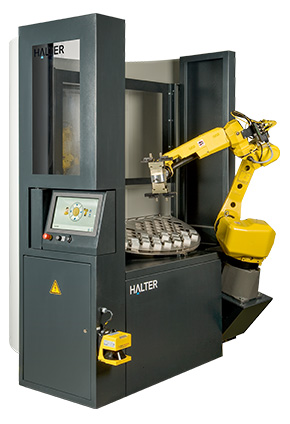
Halter Universal Premium 25/35
The Universal Premium 25/35 by Halter CNC Automation BV is a robotic loading system for turning and milling. It covers the complete range of workpieces up to 27 cm (10.63 in).
A shaft-handling option is available for workpieces up to 44.9 cm (17.71 in.).
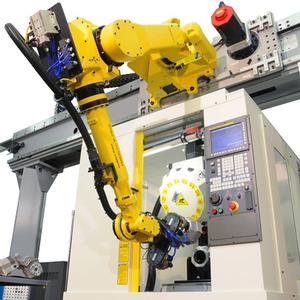
FANUC Toploader Series Robots
FANUC’s series of top loaders includes overhead, rail-mounted robots offering six-axis articulation, modular construction, and electric servo drives.
With a wide selection of rail lengths, a payload range of 20 to 200 kg (44 to 440.9 lb.), and a reach of 1.6 to 2.2 m (5.2 to 7.2 ft.), the Toploader series is suitable for a variety of industries and applications.
Haas Robot Package 3
The Haas Robot Package 3 is a fully integrated, plug-and-play, 50 kg (110.2 lb.)-capacity system for Haas machines. The Haas control system fully controls the robot.
The Haas Robot Package 3 includes a six-axis robot, the software interface for direct control through the Haas machine, an electrical interface box, and safety guarding. It also has all necessary solenoids, hardware, and cables.
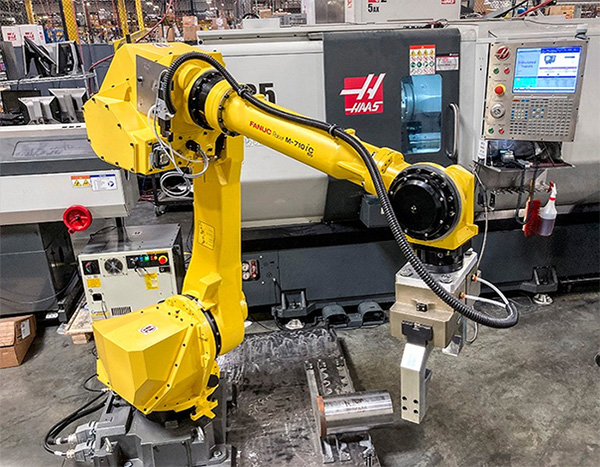
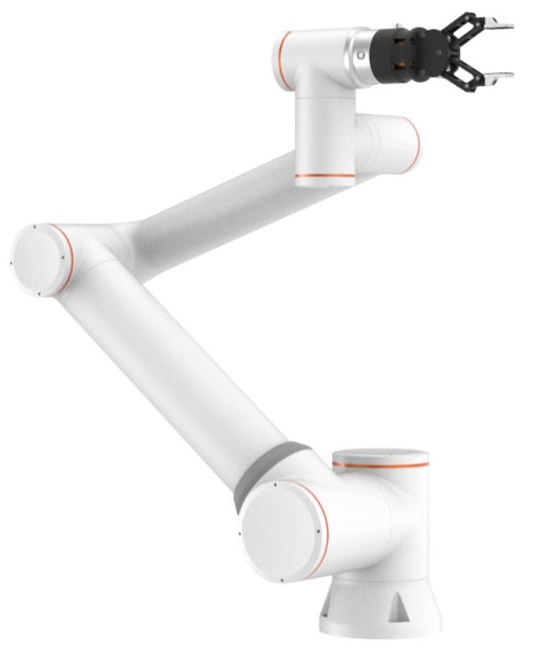
EVS collaborative robot
The EVS cobot arm is mainly used for handling, palletizing, and picking and placing. It can also work in arc welding with high reliability and performance.
This cobot is able to operate multiple procedures in narrow spaces thanks to its lightweight, compact structure. The collaborative features allow users to extend their time and space, and they can liberate humans from repetitive work and hazardous environments.
UR20 cobot
Universal Robots' UR20 collaborative robot is built for higher payloads, faster speeds, and superior motion control, all within a lightweight, small-footprint system for optimal versatility within an existing production space.
No special electrical hookups or costly wiring solutions are required. Even with the big step up in performance, a single-phase standard power outlet is all that’s needed to power the UR20.
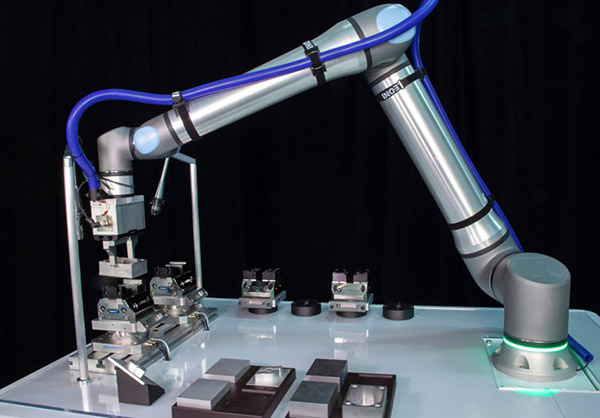
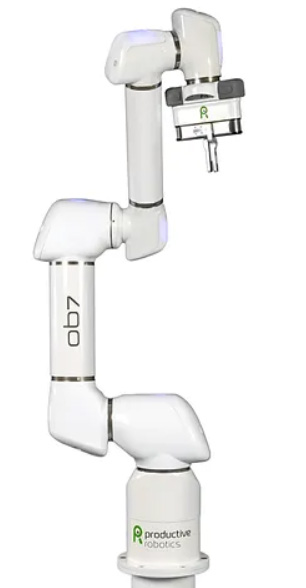
Productive Robotics OB7 cobot
With a seven-axis robot arm design, Productive Robotics' OB7 cobot provides flexibility, maneuverability, and integration into existing workstations and can help a wide range of industries. Each member of the OB7 family is built with a “no programming” user interface, making job teaching simple and fast.
In addition, each cobot model can be equipped with the human-like sense OB Vision, providing even simpler, faster, and more efficient robot training and operation.
The future of CNC robotics
The fast development of CNC robots is revolutionizing the manufacturing sector. Here are some factors to consider about the future of these technologies:
Advances in CNC machining and robotics
- CNC machinery and AI-powered robots can improve production.
- CNC machines will become more customizable with better sensors and software.
- 3D printing and additive manufacturing will continue revolutionizing the creation of complex and expensive components.
Trends in CNC robotics
- Collaborative robots are boosting industrial production without compromising worker safety.
- Smaller manufacturing equipment will make CNC technology accessible to smaller firms and home workshops.
- Cloud and analytics technologies can track and enhance CNC operations in real-time.
CNC robots to affect many sectors
- CNC robots could make cars lighter and more fuel-efficient.
- CNC machining can make complex parts for aircraft engines and other important components.
- CNC technology's accuracy and versatility allow for patient-specific implants and prostheses.
By enabling reliable and exact mass production of even the most complex components, CNC machining and the latest robots are reshaping manufacturing.
In addition, the global robotics market could be worth $34.94 billion this year, estimated Statista. The cutting-edge technology is helping general machining as well as robotics.
While robotics adoption is well behind that of CNC turning machines, they can complement each other as they advance together. Note, however, that CNC robots do require high skill and training to operate effectively.

About the author
Vincent Hua is the marketing manager at TSINFA, a Shandong, China-based producer of CNC machinery. He is passionate about helping people understand technological innovations and complex manufacturing processes.
Article Topics
Latest in Supply Chain
Talking Supply Chain: What is going on along the Mexican border? Global Warehousing Market Expected to Grow by $107B by 2028 CEVA Strengthens Operations With Bolloré Logistics Acquisition C.H. Robinson Expands in Southeast Asia with New Philippines Office DOF Group to Acquire Maersk Supply Service in $1.1 Billion Deal Why Companies Should Look to LLMs, Not Chatbots, For Their AI Needs Retail Supply Chains Embrace AI to Improve ESG Compliance More Supply Chain










